To celebrate the cream of the incoming crop of LCF MA graduates we have been speaking to each of our favourite students to learn more about their collections and their experiences at LCF. We kicked off this year's series with prize winning Matteo Molinari before turning our attentions to the wood craft of Yan Liang. Now it is time to highlight a hugely talented footwear design graduate that left this budding shoeist breathless.
Michelle Quick's graduation collection challenges traditional gender roles within craft practice by combining inherently feminine crafts with men's bespoke footwear. I was taken by her ability at combining various shoe age old making techniques with unusual materials. Entirely made by hand, the collection showcases intricate stitching, various welting techniques and utilizes cow horn as a structural and decorative element to stunning effect. Here we talk to the design talent to hear about her experiences at LCF, learn more about the processes and techniques used within the collections and reveal her hopes for the future...
The collection in Illustator
SS: Congratulations on more than playing your part in an exciting MA show (in terms of menswear in particular). How did it feel seeing your finished designs on the catwalk?
Michelle Quick: Thank you, it was an amazing experience. Footwear is generally displayed in a static exhibit, which is great for getting to look up close and see the details but it's completely different to see them on the foot and in motion. It was important for me to showcase the collection in both ways, so I paired up with MA Menswear designer Mio Jin. We both admire each other's work and thought our collections worked well together. The show was great, it was so exciting and really the end of all the hard work that had led to it. The shoes are now on display at Victoria House.
The Dress oxford catching the eye on the display at Victoria House
SS: Describe the moment you realised that you wanted to become a footwear designer?
Michelle Quick: I was attending The School of The Art Institute of Chicago, studying textiles and general art/design. When I took one of the shoe making classes in my 2nd year, something just clicked - I felt it combined all the disciplines I enjoyed into one craft. I continued to study footwear there and combine it with my other classes, I haven't stopped since.
The Derby shoe standing proudly at Victoria House
SS: What attracted you to the LCF (Cordwainers) MA course in particular? What was the best thing about your course? And the worst?
Michelle Quick: After graduating from SAIC, I felt I still needed something before I could start my career. Resources are limited in The States for shoe making and there aren't any schools that offer an MA in Footwear. The UK is a shoemakers mecca in comparison. Cordwainers has an incredible history/alumni list but the MA Footwear and Artefact programs at LCF are very new and innovative, which is a great balance.
The best part of the course is the resources that are available to you - amazing facilities, knowledgeable staff - and that you are encouraged to push boundaries and try new things. It's really a self-taught course, the resources are there and you have to be motivated and utilise them.
I wish the course would have been longer, maybe two years instead of a year and a half because it was so intense and you really had to put any outside priorities on hold. I do think the timing for releasing our final collections is good though, just before LFW.
Boat Shoe. Nubuck and rough suede upper, concealed wedge and horn strip heel. Image by Tim Medley
SS: The collection challenges traditional gender roles within craft practice by combining inherently feminine crafts with men's bespoke footwear. Was this the driving inspiration behind it?
Michelle Quick: Definitely. I did a lot of knitting, weaving, and embroidery during my BA and when I came to London and started investigating the bespoke shoe shops here, I realised that a lot of crafts are still very gender specific. I wrote my thesis on the origins of gender roles in different crafts and how they can still hold true today. Obviously there are men who knit and women who make shoes or do wood-working, but there is still usually a dominant gender. For my final collection, I wanted to combine various crafts and make objects that feel somewhat neutral.
Stitch Oxford. Image by Tim Medley
SS: The collection features intricate stitching, various welting techniques and utilises cow horn as a structural and decorative element but how would you describe the collection in your own words?
Michelle Quick: For me, the collection is about balancing masculine and feminine characteristics - I used contrasting textures and style lines to establish that dialogue. I also wanted to creating something that felt modern and fresh even though I was using traditional craft techniques. Even though the designs are rooted in my concept and body of research, it was still about making shoes that people would desire and want to wear.
Boat Shoe with horn strip on the heel. Image by Tim Medley
SS: Could you talk us through a few of the main processes involved?
Michelle Quick: Hand-stitching onto leather was a new thing for me, it's very different than fabric because you can't make a mistake the same way you can with fabric because the hole from the needle is permanent. I had to measure and mark out all the stitch marks and really take my time with it. It changed the way I had to assemble the shoes.
Most of the shoes are hand welted. After the upper is lasted, you hand stitch a strip of leather (the welt) to the upper and through the insole - this stitching is hidden. You then stick the sole on and stitch through the welt and the sole - this is the stitching that is exposed around the shoe. It's an incredibly laborious process, you have to twist and wax your own thread and taper the ends so they can be attached seamlessly to flexible needles. You are stitching through very thick soling leather and have to make a hole first with an awl - my wrists were in a lot of pain for a while.
Horn quarter piece on the Monk Shoe
SS: Cow horn is one of the most prominent decorative and structural components in your collection. What attracted you to this material?
Michelle Quick: I've always been fascinated with horn objects, I love seeing old horn combs and caviar spoons in museums. The colours are so varied and you can polish it to such a high shine. It's a material that is present in all bespoke shoe houses (shoe horns, brushes, etc) but is rarely used on the shoes themselves. I was interested in how it could be used to adorn shoes in a new way.
It was difficult to figure out how to work the horn. There are very few resources online or in books and almost no companies still working with it. My initial research was quite frustrating. I was very fortunate to come across Abbeyhorn, the last remaining horn-workers in the UK (see below). After getting guidance from them, I was able to come back to my studio and experiment and figure out the process that worked for me. It does smell pretty bad (like burnt hair) when you are sanding and heating it, so my course-mates were never very happy with that.
The cowhorn toe cap on the Dress Oxford. Image by Tim Medley
SS: How difficult was it to work with?
Michelle Quick: It's an unpredictable material, each horn is unique in it's colouring, it also has areas that are more dense so it doesn't always heat evenly and you end up with kinks when you mould it. I was obviously making pairs so if one piece didn't work out I generally had to redo both to make them match. It took me a while to get comfortable and figure out the best way to do things.
A closer look at the horn toe cap. Strips of horn have been sanded together.
SS: All of your products are, of course, handmade and feature intricate detailing. How long did each pair take to make?
Michelle Quick: All of the shoes had different areas that took more time than others, some have a lot of hand-stitching while others only a hint, some have a traditional welted sole and others a cemented sole, etc. I calculated that they all took between 30-60 hours each, depending on the level of difficulty. That is from patterning to finished product, but doesn't account for the few months when I was experimenting and prototyping.
Desert boot in Nubuck and rough cut suede upper. Image by Tim Medley.
SS: In Abbeyhorn and Metropolitan Leather, you worked alongside some great craftsman, how did you find them and how receptive were they to your designs and what did they make of the collection?
Michelle Quick: The people I worked with were so amazing. I've found that if you are genuinely interested in someone's craft, they are more than willing to help you out or give you advice.
The quality of the veg tan leather at Metropolitan is incredible and the colourist Stuart can just look at the swatch you've brought in and mix up dye that's a perfect match instantly. They custom dyed all of my linings to match the threads and I also got soling leather from them.
Abbeyhorn was a great resource for me. They make mostly traditional horn objects and don't deviate from their catalogue too much, so I think they were happy to help me try and use the horn in a new way. I didn't understand the limitations of the material at first, so my ideas were a bit far fetched but the owner Paul helped show me what was possible and how it could be achieved.
I was also advised on my welting and other shoe making aspects by Carreducker. Welting is something you need to learn directly from a person (like most crafts), I had tried to teach myself from books but it was all the little nuances that James and Deborah taught me that allowed me to make shoes to the quality that I have.
I've had nothing but good feedback and support from everyone I've worked with, I feel lucky to have established relations with these companies.
Jodhpur boot with horn and leather strap. Image by Tim Medley
SS: I know this is a difficult question but is there anything that you're most proud of?
Michelle Quick: I'd have to say I'm most proud of how much my skills have developed throughout this course. I feel that my design skills are much stronger and that the quality and speed of my shoe making has greatly improved. It's hard to believe that the course was only a year and a half because it feels like so much has changed.
SS: What advice would you give a prospective footwear design student?
Michelle Quick: I think that learning the making process can only make you stronger as a designer, the more you understand about the product, the more you can experiment and push the actual design.
A closer look at the handstitched upper with raw edge and Herringbone stitch on the Desert Boot. Image by Tim Medley
SS: Finally, what would you like to achieve in 2011 and beyond?
Michelle Quick: My dream is to find a job where I can have a balance between designing and making. The craft side is so important to me, but I don't necessarily need to be making shoes in a workshop all day. Equally, I wouldn't like just churning out designs that I didn't have a tactile hand in somehow. It's all up in the air right now, I want to stay in London for a while and I would like to continue with men's footwear. I think it will be important to work for established companies before trying to pursue anything on my own. Hopefully only good things are to come.
The stacked leather heel on the Derby. Image by Tim Medley.
If the above leaves you desperate for more, I happily point you in the direction of Michelle Quick's informative tumblr. There can be little doubt that this was a labour of love and the results surely make the hard graft worthwhile. The graduate ultimately showcases a real and exciting passion for shoe making. Each design is close to bursting point with meaningful details but nothing feels superfluous or unnecessary. There is a real balance between them. The diverse details combine to create shoes to truly covet. The real surprising element for me is that each shoe exudes a well crafted quality that is most rare to find in a graduate collection. I for one am excited to see what Quick does next but one thing is for sure, my feet will hopefully be treated to a pair one day soon.

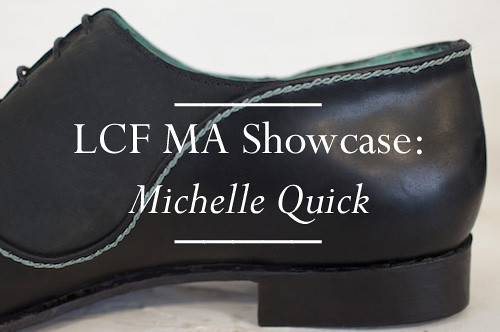
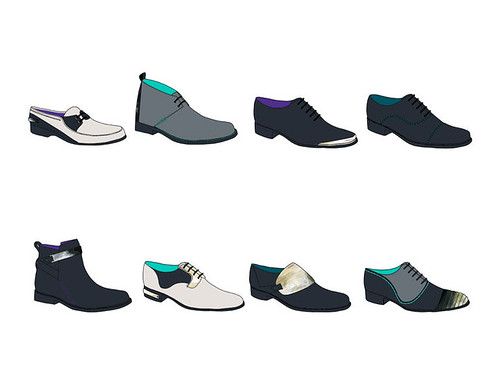
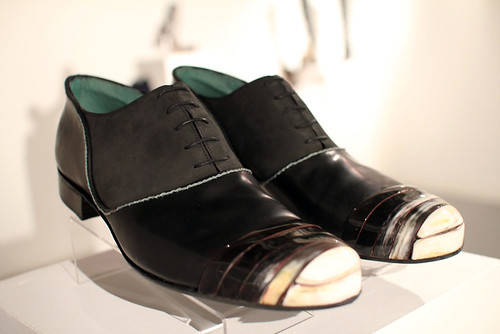
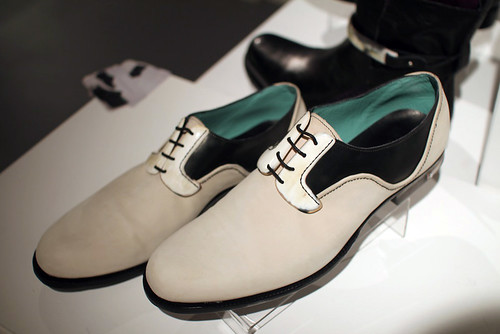

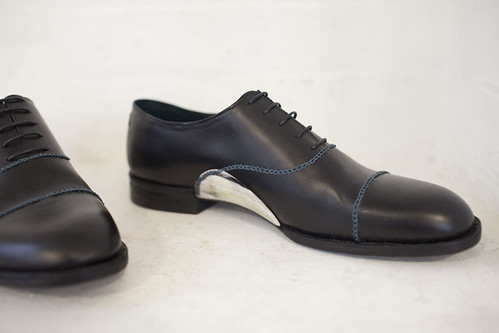
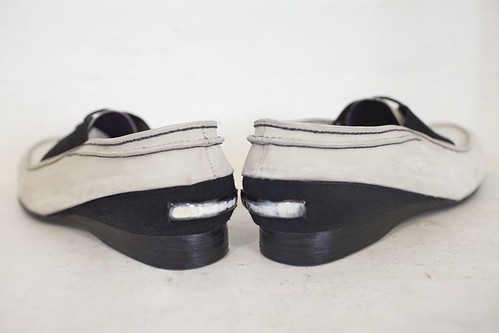
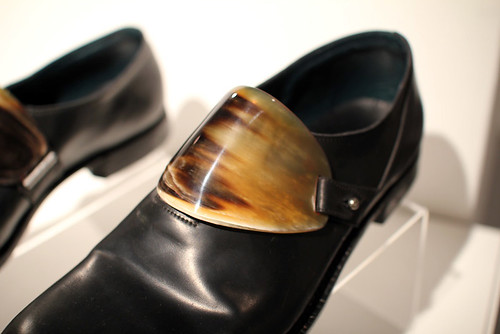
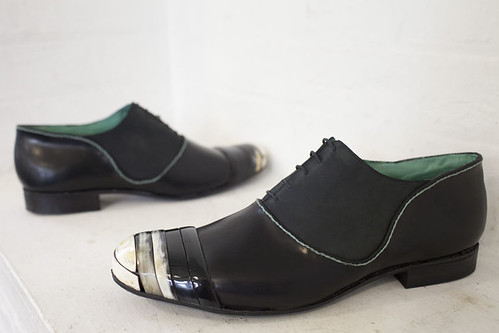
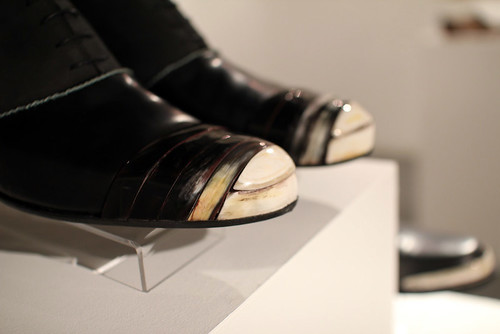
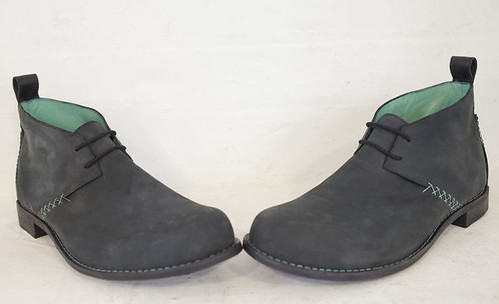

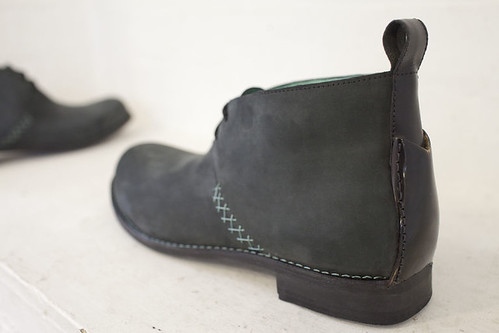
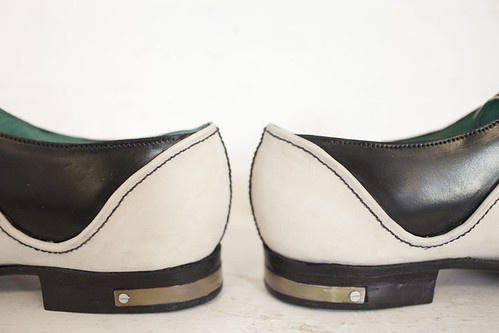
8 comments:
wow those black ones with the silver half circle are amazing.wonder where i can buy those. wonder how much they cost?
It's the first time I saw someone use cow horn as embellishments on shoes. Very intriguing and beautiful as well!
Wow!! Those horn toecaps are beautiful.
I love the horn detailing on these pieces, especially the monk shoe. Thank you so much for passing this on.
Great collection!!
Playon: A fine choice. Why not drop Michelle an email? mbqhandmade@gmail.com
Michael: No problem at all! It was the horn detailing that really caught my eye.
Naboonies: Neither have I and she has used it so well here.
Mr Hare: High praise indeed. I'm sure your comment will make Michelle's week!
Anonymous: Agreed!
I was there on the night too, and particularly liked these shoes. Also did a post on the show, which you can see at www.poptuckshop.com with shoes by Charlie Goldthorpe and Ruth Jones among other things!
very nice Michelle! I really like the jodhpur boots
Post a Comment